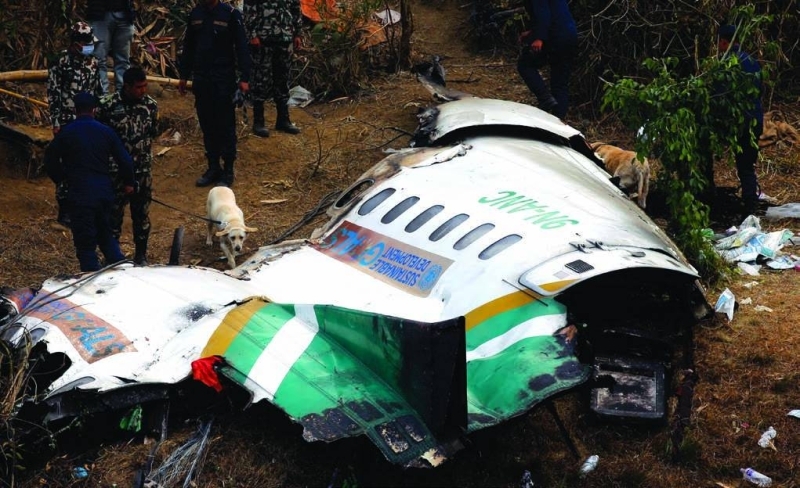
The preliminary accident investigation report of the Yeti Airlines flight that crashed in Pokhara on January 15 hints at engine malfunction behind the deadly accident, in which 72 lives, including that of four crew members, were lost.
Unveiling the report today, the Aircraft Accident Investigation Commission suggested that the Civil Aviation Authority of Nepal should conduct a study at the old Pokhara domestic airport and newly-inaugurated Pokhara Regional International Airport to determine the appropriate flight path that allows the criteria for a stabilised visual approach to be met, taking into consideration simultaneous operations before resuming visual approach on Runway 12 of the new airport.
As per the report, the ATR 72- 212A of Yeti Airlines 9N-ANC was operating scheduled flights between Kathmandu and PRIA on January 15. The same flight crew had operated two flights on the Kathmandu-Pokhara and Pokhara-Kathmandu sector that very morning. The accident occurred during a visual approach for Runway 12 at PRIA on the crew's third flight of the day.
The wreckage was located in a gorge on the banks of the Seti Gandaki River.
The flight was being operated by two captains, one of whom was in the process of obtaining aerodrome familiarisation for operating flights to Pokhara, while the other was an instructor pilot. The captain being familiarised, who was occupying the left-hand seat, was the pilot flying (PF), and the instructor pilot, occupying the right-hand seat, was the pilot monitoring (PM), the commission informed.
The take-off, climb, cruise, and descent to Pokhara were normal. During the first contact with Pokhara tower, the air traffic controller had assigned runway 30 to flight 9N-ANC for landing. But during the later phase of the flight, the crew requested and received clearance from ATC to land on Runway 12.
At 10:51:36, the aircraft descended from 6,500 feet at five miles away from PRIA and joined the downwind track for Runway 12 to the north of the runway. The aircraft was visually identified by ATC during the approach. At 10:56:12, pilots extended the flaps to the 15 degrees position and retracted the landing gear.
The take-off (TO) setting was selected on the power management panel.
At 10:56:27, the PF disengaged the autopilot system at an altitude of 721 feet above ground level (AGL). The PF then called for 'FLAPS 30' at 10:56:32, and the PM replied, "Flaps 30 and descending." The flight data recorder (FDR) data did not record any flap surface movement at that time. Instead, the propeller rotation speed (Np) of both engines decreased simultaneously to less than 25 per cent and the torque (Tq) started decreasing to zero per cent, which is consistent with both propellers going into the feathered condition.
On the cockpit voice recorder (CVR) area microphone recording, a single master caution chime was recorded at 10:56:36.
The flight crew then carried out the 'Before Landing Checklist' before starting the left turn on to the base leg. During that time, the power lever angle increased from 41 to 44 per cent.
At that point, Np of both propellers was recorded as non-computed data (NCD) in the FDR and the Tq of both engines was at zero per cent and not producing any thrust.
When both propellers were feathered, the investigation team observed that both engines of 9N-ANC were running flight idle conditions during the event flight to prevent over torque. As per the FDR data, all the recorded parameters related to engines did not show any anomaly.
At 10:56:50 when the radio altitude callout for 500 feet was enunciated, another 'click' sound was heard. The aircraft reached a maximum bank angle of 30 degrees at this altitude. The recorded Np and Tq data remained invalid.
The yaw damper disconnected four seconds later.
The PF consulted the PM on whether to continue the left turn and the PM replied to continue the turn. Subsequently, the PF asked the PM whether to continue to descend, to which the PM responded it was not necessary and instructed to apply a little power.
At 10:56:54, another click was heard, followed by the flaps surface movement to the 30 degrees position.
When the ATC gave the clearance for landing at 10:57:07, the PF mentioned twice that there was no power coming from the engines. About 20 seconds later, power levers were advanced first to 62 degrees and then to the maximum power position.
It was followed by a 'click' sound at 10:57:16. One second after the 'click' sound, the aircraft was at the initiation of its last turn at 368 feet AGL, the high-pressure turbine speed (Nh) of both engines increased from 73 to 77 per cent.
It is noted that the PF handed over control of the aircraft to the PM at 10:57:18.
At 10:57:20, the PM (who was previously the PF) repeated again that there was no power from engines. At 10:57:24, when the aircraft was at 311 feet AGL, the stick shaker was activated, warning the crew that the aircraft angle of attack (AoA) increased up to the stick shaker threshold.
At 10:57:26, a second sequence of stick shaker warning was activated when the aircraft abruptly banked towards the left. Thereafter, the radio altitude alert for 200 feet was enunciated and the cricket sound and stick shaker ceased. At 10:57:32, the sound of impact was heard in the CVR. The FDR and CVR stopped recording at 10:57:33 and 10:57:35, respectively.
During the time of the crash, the wind speed was light with three to five knots; the prevailing visibility was six kilometres; the temperature was measured at around 14 degrees Celsius; the sea level pressure was recorded 1,015 hpa; and the sky was almost clear with only a few clouds (one to two Octas).
The AAIC has stated that further investigation will focus on the circumstances under which both propellers went into the feathered condition, human factors, and visual approach procedures, including simultaneous operation of both national and international airports.